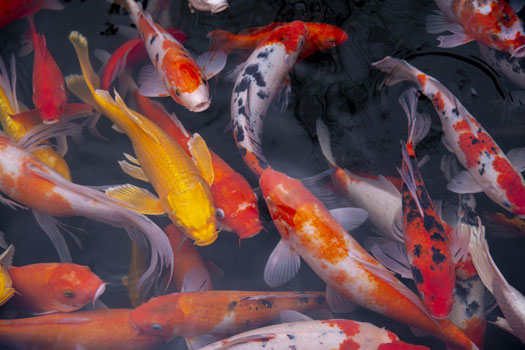- Your shopping cart is empty!
How Do You Aerate & Oxygenate a Koi Pond?

Similar to aquariums, there are various methods to provide water surface aeration and oxygenation to koi ponds, and not all of them require electricity. However, some of the most efficient aeration and filtration systems feature electrical power plants. You may have seen photos and videos of elaborate koi ponds kept by Japanese aquarists that seem to do very well with just a waterfall, but you don’t get to see the intricate aeration and oxygenation systems. In many cases, the waterfall is mostly ornamental, and the pond water is constantly treated by intricate pumps and pond filters. Here are the basics of aeration and oxygen levels you should know before setting up a pond.
Understanding the Oxygenation Process
Aeration and oxygenation go hand in hand. Whenever water is set into motion within a pond, oxygen molecules will spread all around. The oxygen levels of still water will always be lower, and this is what you should avoid. Some hardy and resilient pond species can get by with low oxygen levels, but this isn’t the case with koi. Aeration also stimulates a gaseous exchange at the pond surface, and this is part of a purification process. Ideal oxygenation consists of more than just aeration. There’s a chemical component that can be complemented by organic means, such as plants and live filters.
Aeration by Itself Isn’t Enough
The most attractive koi ponds often feature fountains, waterfalls, or water mills. These are all recommended because they move water around, but many times they won’t be sufficient in terms of providing oxygen. In fact, a pump and filter system will be more efficient in terms of oxygenation than a single mechanical system such as a waterfall. The ideal situation is to combine everything that can provide pond fish with plenty of oxygen, which may include plants as well as a certain mix of species and microorganisms.
Avoiding Oxygen Depletion
The ultimate goal of aeration and oxygenation is to avoid depletion, which happens when the level of oxygen production is lower than the consumption. Let’s say you have a male and female koi swimming in a 500-gallon pond with some plants. In this case, the aeration that a single pump and the fish provide by swimming may supply sufficient oxygen, but adding a single sturgeon or large goldfish may tip the scales toward oxygen starvation and depletion. You can never go wrong with mechanical aeration along with the pump and filter system.
Aeration and Oxygenation According to the Season
If you live in a region where pond water will freeze in the winter, koi and other pond species will take advantage of the increased capacity of colder water storing more oxygen, but you’ll still need a small heating device that keeps an open spot free from ice at the surface for air exchange. Once temperatures rise, you should implement every method to provide oxygenation, including using mechanical aeration, pumps, and filters, replacing pond water, adding fresh bacteria, cleaning as often as possible, introducing more plants, and improving the nourishment of your fish.
In addition to pumps and filters, there are several other koi pond supplies you’ll need to properly care for your pond. At Aquatic Warehouse, we have everything you need to keep your pond looking beautiful and its inhabitants happy and healthy. Take a look at what we have to offer on our website, or give us a call today at 858-467-9297.
